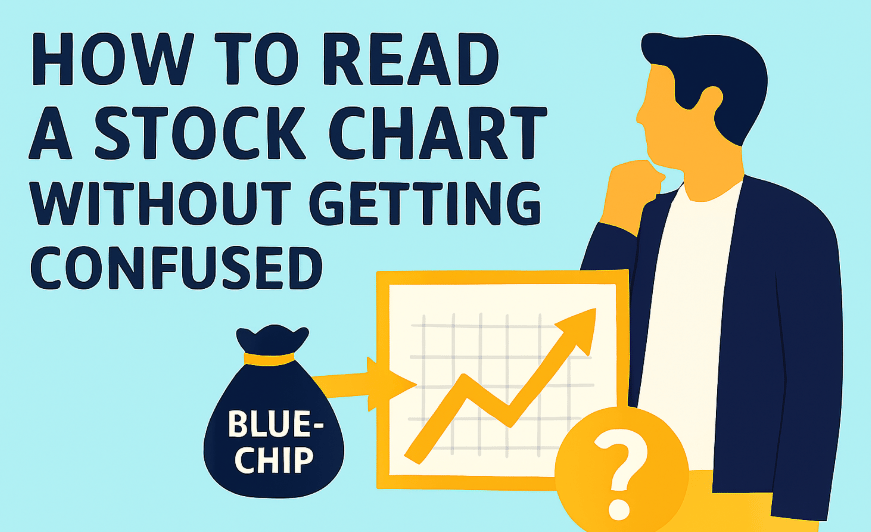- Live Life Grow Wealth
- Posts
- 📈 Series 2 Day 5: How to Read a Stock Chart Without Getting Confused
📈 Series 2 Day 5: How to Read a Stock Chart Without Getting Confused

Today’s Headline
💸 Series 2: Stock Market Basics
📈 Day 5: How to Read a Stock Chart Without Getting Confused
When I first started investing, I used to look at stock charts and feel totally lost. The lines, the colors, the ups and downs—it all looked like a heartbeat monitor gone wild. But over time, I realized something powerful: charts aren’t as scary as they look. In fact, once you understand what they’re telling you, they can become one of your best friends in making smart investment decisions.
Today, I want to help you see stock charts the same way I do—simple, useful, and surprisingly fun once you get the hang of it. Let’s take this step by step, and by the end of this, you’ll feel confident looking at any stock chart without feeling overwhelmed.
"Boost your investment strategy by unlocking the power of CTV advertising with Roku Ads Manager—learn how to maximize returns this holiday season. Click here to explore!"
Find your customers on Roku this Black Friday
As with any digital ad campaign, the important thing is to reach streaming audiences who will convert. To that end, Roku’s self-service Ads Manager stands ready with powerful segmentation and targeting options. After all, you know your customers, and we know our streaming audience.
Worried it’s too late to spin up new Black Friday creative? With Roku Ads Manager, you can easily import and augment existing creative assets from your social channels. We also have AI-assisted upscaling, so every ad is primed for CTV.
Once you’ve done this, then you can easily set up A/B tests to flight different creative variants and Black Friday offers. If you’re a Shopify brand, you can even run shoppable ads directly on-screen so viewers can purchase with just a click of their Roku remote.
Bonus: we’re gifting you $5K in ad credits when you spend your first $5K on Roku Ads Manager. Just sign up and use code GET5K. Terms apply.
What Is a Stock Chart, Really?
A stock chart is simply a visual story of a company’s stock price over time. It shows how the price has moved—up, down, or sideways—and helps you understand how investors feel about that company.
Every little movement tells a story: excitement when prices rise, fear when they fall, and hesitation when they move sideways. Think of it like a diary of emotions in the market.
When you learn to read these emotions, you gain insight into what’s really going on beneath the surface.
The Basic Parts of a Stock Chart
Before diving deeper, let’s understand what you’re actually looking at when you open a chart. Most charts, whether on Yahoo Finance, TradingView, or Google, have a few key elements:
Price Axis (Vertical Line) – This shows the stock’s price, usually on the right-hand side.
Time Axis (Horizontal Line) – This shows the timeline, which can range from one day to several years.
Candlesticks or Lines – These show how the price moved within a certain time period.
Volume Bars – These are bars at the bottom that show how many shares were traded.
Once you know what these mean, you’ll start seeing patterns instead of chaos.
The Secret Behind Candlesticks
If you’ve ever seen red and green bars on a chart, those are called candlesticks. They’re one of the most common ways to display stock prices.
Each candlestick shows four key things for a specific time frame (like a day):
Open – The price when trading started.
Close – The price when trading ended.
High – The highest price of the day.
Low – The lowest price of the day.
When the candle is green, it means the stock closed higher than it opened (a good day).
When it’s red, it means it closed lower than it opened (a not-so-great day).
Once you understand this, the chart starts to make sense—it’s basically showing a tug-of-war between buyers and sellers.
Why Volume Matters
Price alone doesn’t tell the whole story. You also need to see how many people are trading the stock.
That’s where volume comes in.
If the price goes up with high volume, it means a lot of people are buying—it’s a strong signal.
If it goes up with low volume, it might just be a few buyers pushing it temporarily.
Volume helps you spot whether a move is strong or weak, real or fake. It’s like checking how loud the crowd is cheering during a game—are people really excited, or is it just a few claps?
Trends: The Backbone of Every Chart
One of the simplest but most powerful things you can do is identify the trend.
There are three basic types of trends:
Uptrend – The stock is making higher highs and higher lows.
Downtrend – The stock is making lower highs and lower lows.
Sideways (Range) – The stock is moving between a consistent high and low point.
Trends are your compass.
If you try to swim against the current, you’ll get tired fast. The same goes for investing—ride the trend, don’t fight it.
Support and Resistance: The Invisible Boundaries
Every stock has invisible “walls” that it tends to bounce between. These are called support and resistance.
Support is a price level where the stock tends to stop falling. Buyers step in and push it back up.
Resistance is a level where the stock tends to stop rising. Sellers take profits and push it back down.
When a stock breaks through resistance, it can signal a strong upward move. When it falls below support, it may indicate more downside ahead.
Think of these levels like the floor and ceiling in a room—prices tend to bounce between them until something strong enough happens to break through.
Patterns That Repeat Themselves
Once you start observing charts, you’ll notice that certain patterns keep appearing. That’s because human emotions—fear and greed—never change.
Some common patterns include:
Double Bottom – Looks like the letter “W.” It often signals a reversal from down to up.
Double Top – Looks like an “M.” It can signal the opposite—a reversal from up to down.
Breakout – When a stock moves past a key resistance level with strong volume.
Pullback – A short-term dip before continuing an uptrend.
These patterns don’t guarantee anything, but they help you understand what other investors might be thinking.
Become an email marketing GURU.
Join us for the world’s largest FREE & VIRTUAL email marketing conference.
Two full days of email marketing tips & trends, famous keynote speakers (Nicole Kidman!), DJ’s, dance contests & networking opportunities.
Here are the details:
100% Free
25,000+ Marketers
November 6th & 7th
Don’t miss out! Spots are LIMITED!
How to Read a Stock Chart in 3 Simple Steps
If you’re new to charts, here’s how I personally approach them in a simple way:
Step 1: Identify the Trend
Look at whether the price is generally going up, down, or sideways.Step 2: Spot Support and Resistance
Notice where the price tends to bounce or get stuck.Step 3: Check Volume
See if there’s strong participation behind the move.
That’s it! Don’t overcomplicate it. The more you look at charts, the more natural it becomes.
Common Mistakes When Reading Charts
Many beginners fall into traps when trying to read stock charts. Here are some to avoid:
Overanalyzing Every Wiggle – Small ups and downs are normal. Focus on the bigger trend.
Ignoring the Timeframe – A stock might look bad on a 1-day chart but great on a 1-year chart. Always zoom out.
Chasing After Big Moves – If a stock just jumped 20% in one day, it might be too late to join the party.
Forgetting the Company Behind the Chart – The chart shows the price, not the business. Always know what you’re investing in.
Why Charts Are Only One Piece of the Puzzle
I love charts because they help me see what the market is doing. But I never rely on them alone.
A stock chart tells you what happened—but not why. To make smart investment decisions, you need to combine charts with knowledge of the company’s fundamentals—its earnings, products, leadership, and growth potential.
In other words:
Charts tell you when to look.
Fundamentals tell you what to buy.
When you combine both, you get the full picture.
How I Use Charts Personally
Whenever I consider buying a stock, I first check its chart to understand the trend. I look for:
Is it near a strong support level?
Is the trend upward or downward?
Is the price moving with strong volume?
If everything aligns, I’ll dig deeper into the company’s financials. This balance helps me avoid emotional decisions and focus on logic.
“Unlock access to top-tier startup deals before VCs catch on — click here to explore what VentureScout is quietly revealing to serious investors.”
|
Key Takeaways
Let’s wrap up what we’ve learned today:
A stock chart is simply a visual story of price movements.
Candlesticks show how prices change within a time frame.
Volume confirms whether a price move is strong or weak.
Support and resistance act like invisible walls.
Trends guide your direction—never fight them.
Charts are useful, but they’re only one part of smart investing.
Learning to read charts is like learning to read a new language—it feels strange at first, but once you get it, you’ll see things others don’t.
Final Takeaways
Here’s something I’ve learned over the years: consistency beats complexity. You don’t have to be a chart expert to become a successful investor. You just need to understand the basics, stay patient, and let time do its work.
Start by picking one or two of your favorite stocks and study their charts for a few minutes each day. Watch how they move with the news. Notice how support and resistance play out. The more you observe, the sharper your instincts will become.
Remember, investing isn’t about being perfect—it’s about getting better, one small step at a time.
If you found today’s lesson helpful, stay tuned for the next part of this series. We’ll keep building your confidence, one day at a time, until you feel fully in control of your investment journey.
Your future wealth starts with understanding the patterns today—so take a moment, open a stock chart, and see the story it’s trying to tell you.
[Live Life Grow Wealth]
🎓 Free Masterclasses to Unlock Your Investment Potential
Take your money skills to the next level with expert-led workshops designed to help you grow smarter and faster.
Recommendations Section
|
|
|
|
DISCLAIMER
I make no representations, warranties, or guarantees, whether expressed or implied, that the content provided is accurate, complete, or up-to-date. Past performance is not indicative nor a guarantee of future returns.
I am an individual content creator and not regulated or licensed by the Monetary Authority of Singapore (MAS) as I do not provide investment services.
All forms of investments carry risks, including the risk of losing your entire invested amount. Such activities may not be suitable for everyone. You are strongly encouraged to seek advice from a professional financial advisor if you have any doubts or concerns.










